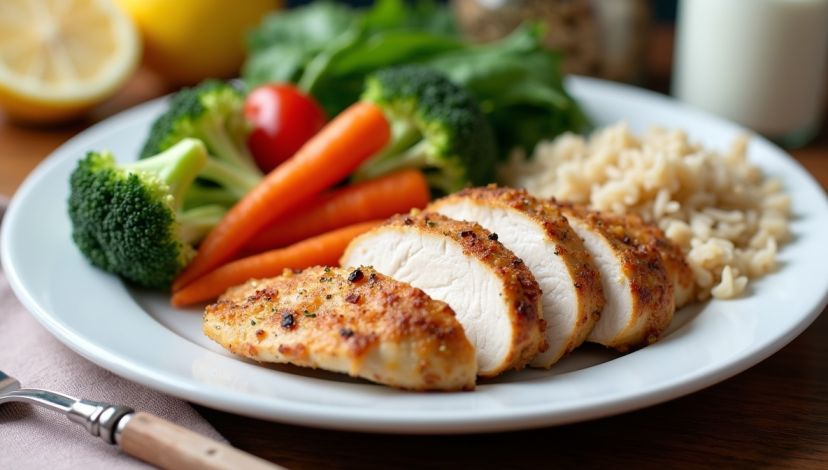Breast is considered one of the most common as well as versatile protein foods in the whole world. Fitness lovers, people interested in healthy food, and cooks at home just adore it since it is slim, contains a lot of protein, and can be cooked easily in so many tasty variations. Knowing the nutrition facts of chicken breast will enable you to make better food choices, whether you are trying to gain muscle and lose weight or adhere to a healthy diet in general.
A detailed nutrition profile of chicken breast, frequently asked questions about its health benefits, and a comparison with other protein sources will be researched in this blog post. In the end, you will know to what extent chicken breast will make an exceptional ingredient to your diet.
Key Points
- Chicken breast is a rich protein but low in fats.
- It has nutritious vitamins and minerals, such as the B vitamins and selenium.
- It promotes muscle building, blood circulation, and weight loss.
How Many Calories And Macros Can A Chicken Breast Have?
Chicken breast has a reputation of being a lean source of protein, which has a relatively low calorie count. Deep fat fried chicken would be 165 calories/ 100 g (3.5 oz) skinless, boneless breast. The serving size is a source of approximately 31 grams of protein and 3.6 grams of fat, and zero carbohydrates. Most of the calories are contained in protein and thus suitable in repairing and increasing the size of muscles.
| Nutrient | Amount per 100g | % Daily Value* |
|---|---|---|
| Calories | 165 kcal | 8% |
| Protein | 31 g | 62% |
| Total Fat | 3.6 g | 5% |
| Carbohydrates | 0 g | 0% |
| Sodium | 74 mg | 3% |
*Calories based on a 2000-calorie diet per day.
This table indicates the composition of nutrients of chicken breast with its highly protein and low fat content. It is an excellent product due to the low fat and zero carbs that make it an ideal product when someone is on a low-carb or a calorie-controlled diet. Nevertheless, do remember that the cooking process, such as frying or the use of sauces, can add a great number of calories and fat.
How do chicken breast nutrition facts compare to those of other chicken cuts?
Chicken breast is compared with other chicken parts like thighs, wings, and drumsticks. Although chicken breast has less fat and is a richer source of protein, other parts can be fattier and contain more calories, with a variety of new tastes and textures, though.
| Chicken Cut | Calories (per 100g) | Protein (g) | Fat (g) | Carbs (g) |
|---|---|---|---|---|
| Chicken Breast | 165 | 31 | 3.6 | 0 |
| Chicken Thigh | 209 | 26 | 10.9 | 0 |
| Chicken Drumstick | 175 | 28 | 6.5 | 0 |
| Chicken Wing | 203 | 30 | 8.1 | 0 |
Chicken breast is the leanest of all this and is thus the choice of the person who is more interested in lowering fat consumption whilst getting the most of the protein content. The thighs and wings, and other cuts are fattier and will not be suitable in rigid diets, though the extra fat can be beneficial in adding flavor to many dishes.
What do chicken breast nutrition facts reveal about its advantages and health benefits?
Besides the high content of proteins, chicken breast provides a great number of useful properties. It is a great source of vital vitamins and minerals such as:
- B6 and B12: needed in the energetic process and mental protection.
- Niacin (Vitamin B 3): Benefits the skin health and digestion.
- Selenium: It is an antioxidant which protects the cells against damage.
Since chicken breast does not have any carbohydrates and has low levels of saturated fat, it promotes heart health and weight control. It is rich in proteins, therefore useful in muscle formation and renovation, hence it suits athletes and other active people.
Also, chicken breast has fats that are of better cardiovascular health than many fats in red meat since they are polyunsaturated and monounsaturated fats.
Note: When using chicken breast, you have to always take the skinless chicken breast, which is the least fat, since the fat in chicken mostly lies in the skin.
What is the ideal way of storing and cooking chicken to preserve chicken breast nutrition facts?
To preserve the nutritional value of chicken breast, the appropriate way of storing and cooking is required. Raw chicken breast may last inside the fridge within 2 days. It can be frozen in an air-tight container and kept fresh even up to 9 months.
In cooking, one should not deep fry or make a lot of oil and sauce, which adds weight in calories and fat. The forms of healthy cooking are grilling, baking, roasting, boiling, or steaming. The techniques maintain the lean protein value and also do not introduce extra calories.
Note: Chicken should be cooked well (165°F or 74 o C) to prevent food poisoning.
To add flavor without extra unhealthy fats or sugars, it is possible to marinate chicken breast with various herbs and spices, lemo,n or yogurt. This means that one can easily consume chicken breasts as a balanced diet.
What Is the Role of the Chicken Breast In Various Diets?
Chicken breast is amazingly versatile, and it can be used in a variety of diets such as:
- Weight Loss Diets: Low-calorie protein content of high-quality foods helps to avoid unnecessary muscle loss and feelings of satiety that accompany weight loss.
- Muscle Building Diets: Protein-containing muscle-building diets aid and repair the muscle-building process.
- Low-Carb/ Keto Diet: It is ideal since it has zero carbs and lean protein.
- Heart-Healthy Diets: Low in saturated fats and high in good fats are helpful to heart health.
- Gluten Free Diets: They are naturally gluten-free and are appropriate for people who have an intolerance to gluten.
Owing to its adaptability, chicken breast can be incorporated in the many meals such as salads, stir-fry, and soup, among others. It has a non-distractive taste that can be combined with different herbs, spices, and sauces, and hence, found in every cuisine across the world.
Conclusion
Chicken breast is a health-packed source of lean protein, which has little fat and no carbohydrates. It also promotes the development of muscles, weight control, and good health owing to its high reservoir of vital vitamins and minerals. Compared with the other kinds of chicken, it is still the leanest and high in protein.
Skinless, boneless chicken breast is the best type to use, coupled with healthy ways of cooking it so that you derive maximum nutritional value. Chicken breast is a nutritious and flexible food whether you are an athlete, a busy individual, or a person wanting to improve nutrition through having a healthier diet.
Warning: Do not neglect the size of portions and the food preparation process so that chicken breast meals can remain healthy and balanced.
FAQ’s
1. What is the number of calories per chicken breast?
Approximately, skinless boneless chicken breast, including 100 grams, has 165 calories.
2. Does chicken breast provide a good source of protein?
That is right, chicken breast contains about 31 grams of protein per 100 grams, which is a super protein source.
3. Is chicken breast fat-free?
Chicken breast contains only small amounts of fat content, approximately 3.6 grams of fat per 100 grams of the meat remains unsaturated.
4. Is chicken breast included in a weight loss diet?
Absolutely. It contains a lot of proteins and few calories, which aid in satiety and muscle retention when reducing weight.
5. What is the ideal way of cooking chicken breast so as to maintain its nutrition?
The effective way to ensure that chicken breast is lean and nutritious is to use either grilling, baking, roasting, boiling, or steaming.



